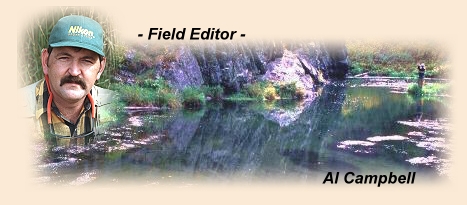|
It has been a hot summer. For two months the
daytime temperatures reached the 90s to the low
100s every day except for a couple of days. That
is the official weather service statement, but in
the area where I live east of Rapid City, it has
been hotter. My neighbor has a computerized weather
station on the shady north side of his house. His
little station tells a different story than the
weather guys do from their station.
According to my neighbor's station, the temperatures
exceeded 110 degrees locally 8 days in July and 7 days
in August. Four of those July days exceeded 115
degrees and three in August did the same. One July
day exceeded 120 by one degree. We only had six days
in those two months that didn't reach 95, and three
that didn't exceed 90.
Also according to his station, we have had less than
half an inch of rain since the last week of June,
and that came in three localized thunderstorms. Other
areas of town and especially some areas south of town
have had more rain by far, but the hill I live on has
been hot and dry. Although I use the water sprinkler
on my lawn on days that it's allowed, I have big cracks
in the lawn that garter snakes can crawl in and out of.
My bird feeders and birdbaths are getting a work out
this year too.
The weather has had an impact on some local streams too.
On July 19, I measured the temperature in Spring Creek
about two miles below Sheridan Lake at 80 degrees in the
morning. I walked the stream (down the middle so I could
see any moving fish) and observed only one trout in
several hundred yards of stream. It was a rainbow
with big white spots and it was swimming on its side.
I doubt it survived the day.
Many of the smaller streams have dried up completely
in their lower reaches again this year. When the
drought does break, it'll take a decade for the fish
and insect populations to recover. Fortunately there
is cooler water in the uppermost reaches of those
streams to hold a seed population for future recovery.
On the other hand, some of our streams are doing very
well. Spearfish Creek has been running near bank full
all summer. They have had a lot more rain over on that
side of the Black Hills than we have had in my location.
Upper Rapid Creek and Castle Creek have also been
getting more rain than most of the Black Hills, and
they have been flowing pretty good. We still have
some great fishing, but we have to choose our
destinations carefully.
Does any of this have anything to do with you? Maybe,
and maybe not. Some of our readers live close to me
and others travel to the Black Hills to enjoy the
fishing offered here. They would be very disappointed
to travel to this area just to find the streams
un-fishable. I would too, if I traveled somewhere
to find my trip was in vain.
In my 16 years of living in the Black Hills, roughly
a third of those years were drought years. In all that
time, I can't recall one year that Spearfish Creek
didn't have good or at least fair water flows. I saw
the lake above Pactola Dam drop 60 feet below its normal
water line in the late 1980s, but I can't remember one
time when Rapid Creek below that dam got too hot or too
low to support a healthy population of fish. We have
always had some places to fish, even when many of the
other local places were un-fishable.
The same is true in other western states as well. When
I lived in Montana, if the water in the Missouri or Smith
rivers got too low or too warm for reasonable fishing,
there was always cool water and fine fishing in the
mountain streams. While the big rivers of the west
are very popular, some of the best late summer fishing
can be found in the smaller rivers and streams in the
mountains, and those streams usually don't get much
pressure. You might have to adjust your course a
little, but your summer fishing vacation doesn't have
to be canceled because your chosen river isn't fishing
well.
You might be fishing a 3wt instead of a 5wt, but streams
like the North Fork of the Teton River or the upper
reaches of the Dearborn River southwest of Augusta,
Montana will reward you with dozens of brookies and
cutthroats when the Missouri River is too warm to be
fishing well. There are dozens if not hundreds of
small streams near the river you planned to fish that
will be fishing great if you'll take the time to search
them out on a map. What they often lack in fish sizes,
they more than make up for in numbers and breathtaking
scenery.
The next time you hear that the Big Hole isn't fishable,
make the trip anyway, and fish some of the small streams
nearby. If Spring Creek in the Black Hills is too hot
to fish, maybe it's time to try another stream like
Spearfish Creek. If the Madison is too warm, maybe
you should discover one of the hundreds of smaller
streams that feed the Gallatin or Madison. You might
just find yourself planning next years trip to include
a few of the other "treasures" you discovered when your
original plans didn't work out exactly the way you intended.
Some of the best treasures are hidden just beyond the
well-traveled highways.
~ AC
|



